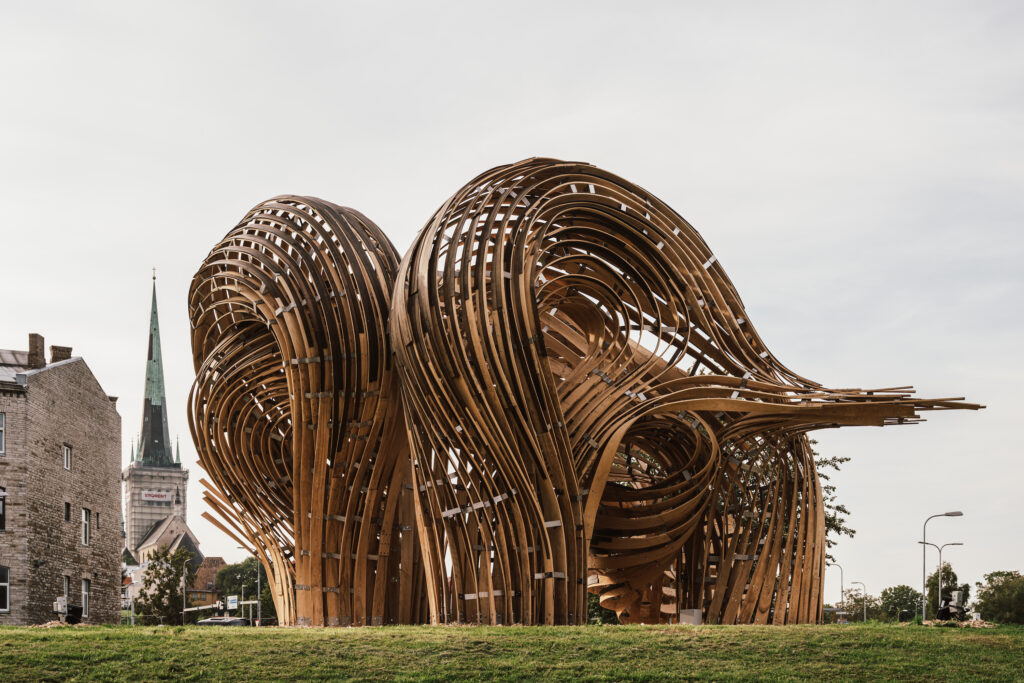Tallinn Architecture Biennale (TAB) „Beauty Matters: The Resurgence of Beauty“, 11.09–15.09 2019.
The head curator Yael Reisner, the curator’s assistants Liina Soosaar (Tallinn) and Barnaby Gunning (London). Organised by Eesti Arhitektuurikeskus
Symposium „Beauty Matters. Just Like Love, It’s Real“, 12.09–13.09 at Creative Hub (Kultuurikatel), Curated by Yael Reisner
Curatorial Exhibition „Beauty Matters“ until 11.09–17.11 2019 at the Museum of Estonian Architecture, Curated by Yael Reisner
Pavilion „Steampunk“ in front of the Museum of Estonian Architecture. Architects Gwyllim Jahn, Cameron Newnham (Fologram, Austraalia), Soomeen Hahm Design (Ühendkuningriik), Igor Pantic (ÜK)
TAB 2019 catalogue „Beauty Matters“. Curated by Yael Reisner, edited by Rebecca Collings’
For some reason, the topic raised by the Tallinn Architecture Biennale in autumn had a fresh and exciting feel. On the one hand, it was foreseeable that the question of beauty is too general and elusive to provide clearly articulated answers during the short event. Then again, the umbrella topic of beauty gave the event an unexpectedly smooth and clear flow as well as a feel of brightness which is by no means irrelevant. Everyone has personal experience with beauty and it is thrilling to attempt to comprehend to what extent it is also intersubjective. Furthermore, the experience of beauty is also accompanied by pleasure that helps to keep the focus on the issue. It was a successful choice of topic also in a sense that it generated wider interest and drew the attention of the mainstream media to the biennale while also allowing in-depth discussions on the state of play in the given field. The London-based curator Yael Reisner should be additionally credited for bringing herself up to speed with what was going on in Estonian architecture and for including local architects and other professionals of the creative industry both in the curatorial exhibition and the symposium. It may all be considered self-evident, however, the previous biennale curated by Claudia Pasquero fell short of the given aspect.
What is the question?
The curator finds it problematic that in the past eighty years, architecture has focussed only on functionality and technology while beauty as a decision criterion has been neglected and considered naïve. Perhaps somewhat surprisingly for many people, she associates such behaviour in architecture with the emergence of the estranged cityscpaes and ecologically unsuitable living conditions. In the curator’s eyes, departure from beauty also stands for departure from man and humanity. Human civilisation cannot exist without the experience of beauty, she says referring to the works of neuroscientists.1 I’m sure that few people would question whether architecture and living environment should speak to people and be ecologically accountable. But whether and how is beauty the unambiguous and universally acknowledged redeeming element, and what is the relation between beauty and the climate crisis, these are already somewhat more complex issues.

How should we understand beauty?
The question is how to define beauty. Do we consider it a superficial luxury item and dealing with beauty a mere form of escapism while the world is gradually sinking under the climate crisis? Or is beauty something growing out of the nature of the object thus representing its inner values and the coherence between the internal and the external?
In philosophy, the question of beauty has been discussed ever since Ancient Greece. In the course of history, the explorations of beauty have been markedly versatile including rather controversial understanding of beauty: from the hedonistic perspective seeing beauty as a provider of pleasure and satisfaction (for instance, Hume) to the idealistic point of view (for instance, Plato, Hegel) that considered beauty as the abstract experience of integrity.2 In early 20th century, interest in beauty began to fade both in philosophy and art. Freud rediscovered the inner inhumanity of man and their pressing need to go to the mat with it. Also art wanted to be honest and not to focus on beauty that was deemed superficial and thus unable to explore the atrocities, urges and desires of the 20th century. Adorno’s diagnosis on the inappropriateness and futility of aesthetic issues is expressed in his line, “To write poetry after Auschwitz is barbaric”. At a time when the vision of mankind tends to be lousy, it is easy to regard beauty as something superficial, subjective and rather trivial, as it would be difficult to associate human nature and its overall efforts with beauty.

The curator does not share the given misanthropic view by saying that we need to update and reconsider the concept of beauty in the contemporary context. Neurobiological studies show that the human experience of beauty is both subjective and objective (the experience of beauty activates the same area of the brain in different people, in other words, the experience of beauty is detected and can be mediated). The neuroscientist Semir Zeki has shown that when we experience different types of beauty (visual, musical, mathematical, moral), the activity in the pleasure centres of our brain increases. The given area of the brain contains a great deal of dopamine leading to physical health and a sense of wellbeing.3
Also the participants of the symposium representing various disciplines expressed their perception of beauty. Among others neuroaestheticist Taylor Enoch representing Zeki’s lab, mathematician Ron Aharoni, philosopher Graham Harman and poet Maria Lee. Many of them described the experience of beauty as a kind of a new epiphany; intuitively perceived order; compression of information in a way that it is easily discernible; the experience of beauty signals that there must be more in it; beauty releases us from the chains of our desires and intentions; beauty cannot be exhaustively explained. The latter is clarified by Harman saying that the opposite of beauty is not ugly but literal (the quality of being exhaustively explained). According to Harman, beauty cannot be exhaustively explained – it is not possible to explain what the Guggenheim Bilbao Museum building means.
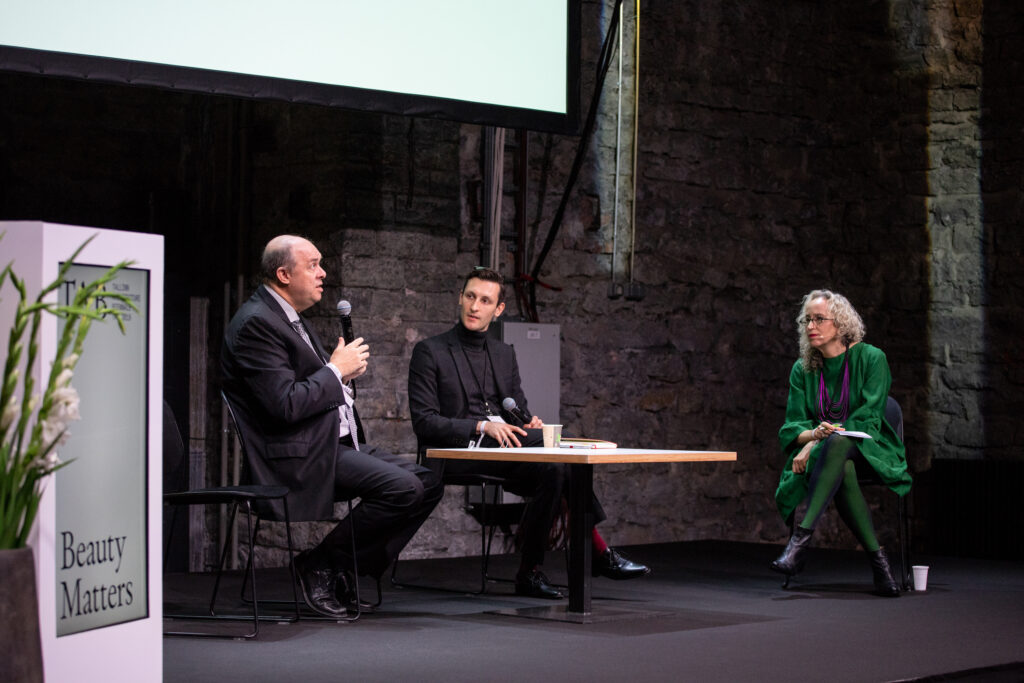
Search for beauty is not perhaps a good formula for creative work, but it directs the choices in the design process and characterises the result. The curator seems to suggest that the artist should not stop until he has gained the experience of beauty in his own creative work. It could be taken as a reminder of work ethic for architects. There seems to be another important question that was not explored at the biennale – how does beauty relate to the following concepts: architecture as a bearer of creative added value, the capacity of the architectural work to speak to people, the artistic image.
The curator’s main message is simple – if architecture is based merely on the pragmatic need and focussed on solving problems, it results in an environment that does not speak to people. Should architecture solve problems? Or should it focus on creating values and something new, thus always encompassing also the descriptive inexhaustibility mentioned above? Instead of colliding head-on with the problems, we should perhaps just keep them in sight so that they would still be solved in the course of the architect’s comprehensive and versatile mental work. The beauty explored by Yael Reisner is by no means superficial, it does not stand for the cheesy property development sale photos – these are basically reverse notions much like Harman’s discussion of literal as the opposite of beauty. The beauty discussed by Reisner stands for plurality relating both poetic and rational decisions.
The exposition “The Utopian Tick” by KadarikTüür Architects at the curatorial exhibition gives good impetus for the debate on whether architecture should focus on problem solving. It tells an allegorical and dystopic tale of the future world governed by an AI-controlled insulation virus wrapping buildings into a layer of thermal insulation. There’s clearly no point in asking what it looks like. Obviously horrible, as also illustrated by the infected pavilion displayed at the exhibition! The message conveyed by Kadarik Tüür may be interpreted in different ways: that building sector is the highly energy-intensive and climate crisis has introduced more pressing issues than beauty. On the other hand, the horrible pavilion illustrates how an engineering solution with a narrow focus on a single problem will lead to caricatures. In other words, their work could also be interpreted as a sketch of the dystopia of over-rationalisation that could be brought about by the abandonment of the human and general considerations – that is beauty in its new meaning after all?

The curatorial exhibition was designed as a public space with a mellow aural and natural environment. The exhibition took you through various visions of a space that is open to technological innovations and aware of ecological issues, but first and foremost, a space that is human and speaks to people. Eight architecture offices had created large-scale installations featuring fragments of the living environment that could be experienced either directly or by means of augmented reality. The works of the exhibiting offices (in addition to Kadarik Tüür Architects also soma, Space Popular, Kadri Kerge, Sou Fujimoto, March Studio, Atalier Manferdini and Barnaby Gunning and Yael Reisner) were quite distinct and rich featuring different approaches to beauty thus characterising the curator’s interpretation of beauty as plurality (not a singular idea) and as an integrator of interpersonal connections.
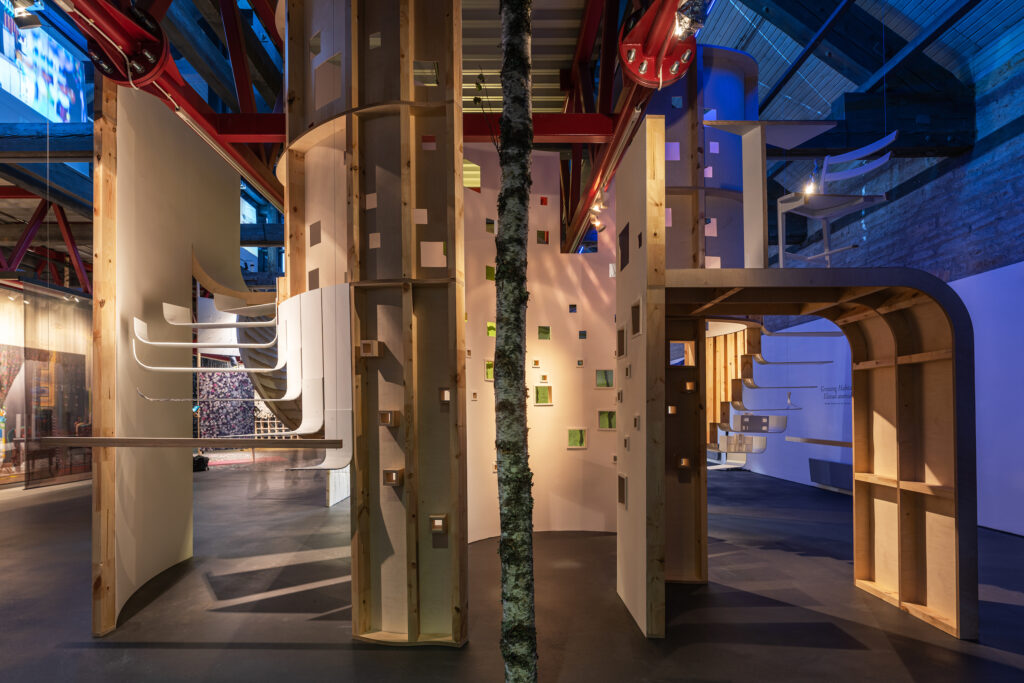
Give me a nice example of beauty!
The fact that it is not a superficial search for beauty is well illustrated by the winning entry of the installation competition. The installation “Steampunk” by young architects Gwyllim Jahn, Cameron Newnham, Soomeen Hahm and Igor Pantic was constructed of hand-crafted steam-bent ash wood. When bending wood in the right curvature, augmented reality glasses were used to show its right position in the drawings. The given technology brings man back to the construction process in a new manner. In this era of 3D printed buildings and robot-milled shells pushing man out of the construction game, he can now literally get his hands on the building process again. In this context, Heidegger’s figure “building is dwelling” gets a new layer as winning the latter back for man. As suggested by the name of the installation, the author is aware of the romanticism of his effort. Is it a nostalgic attempt to build at least something with your own hands, as soon it will probably be done only by robots? Yet, the installation still comes to emphasise that at the time of technologisation, we need to consider what aspects should be fully automatized and where we should retain our involvement. What is our connection with reality based on and what will it be based on in the future and what are our common denominators as a society?
It is impossible not to love the installation, it is truly captivating. The installation by Gilles Retsin at the previous TAB was enticing due to its intellectual clarity. Retsin’s installation provided a successful vision of a highly short and simple production chain – the author spent only 2×4 days in Tallinn to erect the installation. Jahn spent an entire rainy summer hand-crafting his work. Does that kind of handiwork stand for elitism in today’s world or is it just another way to decrease overproduction and overconsumption?
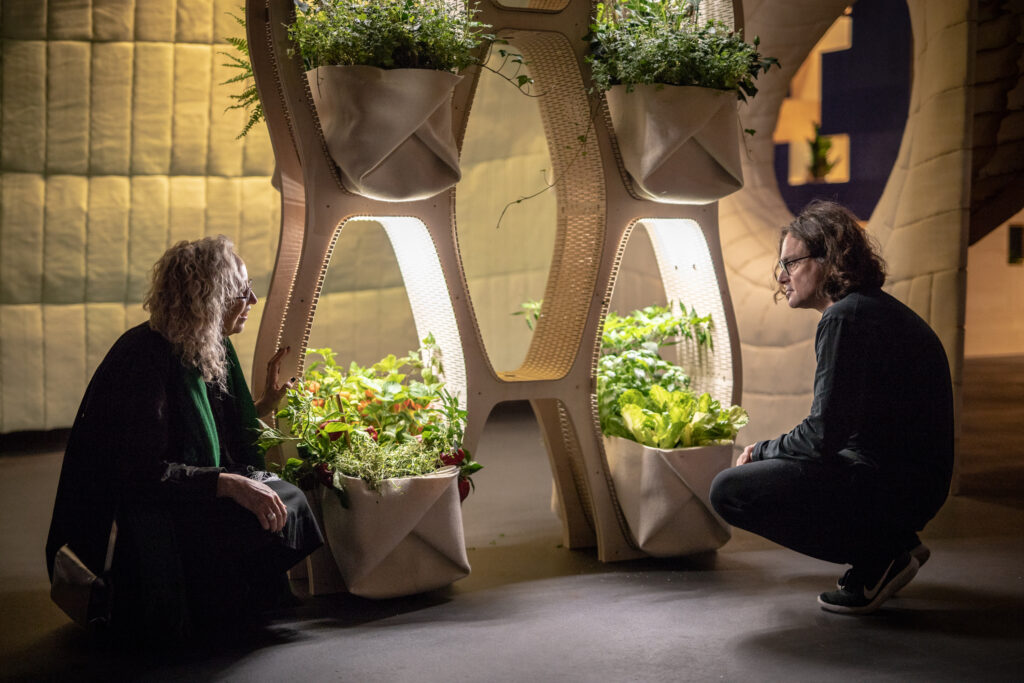
It is also worth noting the clear and beautiful biennale catalogue including essays by the participants of the symposium and also introducing the projects of the curatorial exhibition, vision competition, installation competition and the exhibitions by the architecture schools. The texts are relatively comprehensive making the catalogue a good starting point for a reader interested in the relations between contemporary architecture and beauty.
In case it is beauty that speaks to and joins people, then it cannot be a singular but has to be a complex concept. Harman’s suggestion – beauty cannot be exhaustively explained by description – makes it difficult to talk about it. Neuroscience has shown that the experience of beauty combines the subjective and the objective and people need the experience of beauty for their wellbeing. Reisner hereby adds a creative and rational synthesis by means of visual thinking. In the end, the message of the biennale resounded: although architecture may help to solve (and it does solve) problems, we should not regard it as a primary tool for solving social etc. problems but as a creator of values, novelty and wellbeing. In the 20th century, the creative part of architecture that can also deal with the question of human condition has been undeservedly overshadowed by pragmatics.
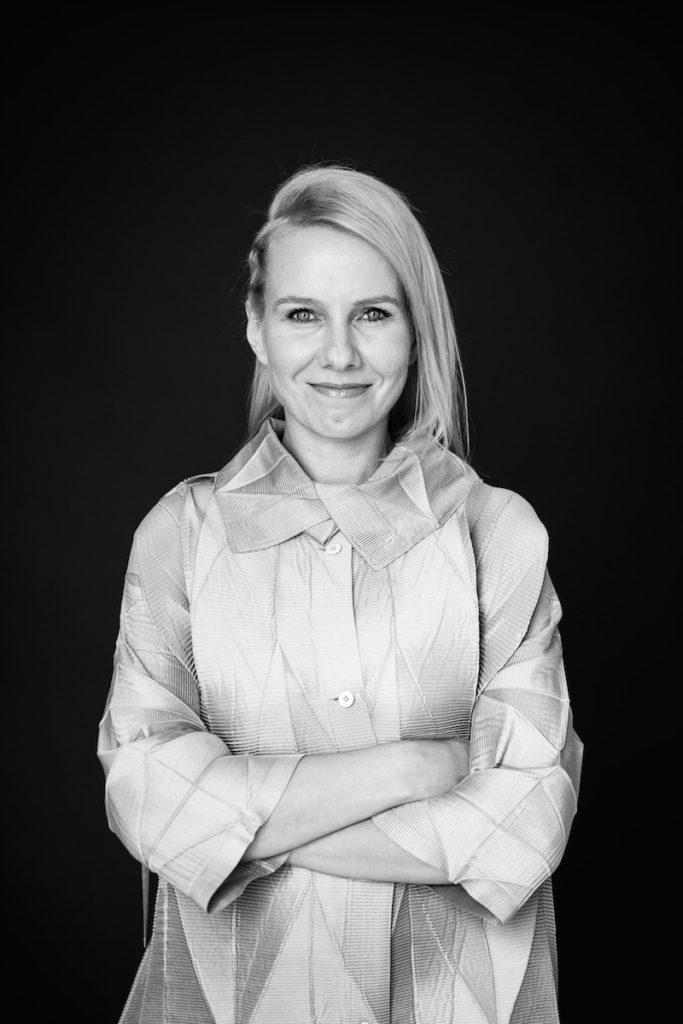
KAJA PAE is an architect and physicist, since 2017 also the editor-in-chief of the Estonian Architectural Review Maja.
HEADER photo by Tõnu Tunnel
PUBLISHED: Maja 99 (winter 2020), with main topic Rural Insights
1 Yael Reisner, Arhitektuur ja ilu. Essee ilu olulisusest. – Ilu loeb. TABi kataloog, 2019, lk 30.
2 Stanford Encyclopedia of Philosophy https://plato.stanford.edu/entries/beauty/
3 Semir Zeki, https://neuroaesthetics.net/2011/08/21/toward-a-brain-based-theory-of-beauty-ishizu-zeki-2011/

